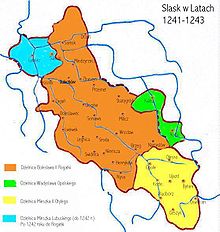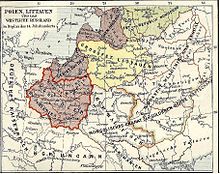- Lubusz Land
-
Lubusz Land (Polish: Ziemia Lubuska, Lubusz; German: Land Lebus) is a historical region and cultural landscape in Poland and Germany, on both sides of the Oder river.
Originally the settlement area of the West Slavic Leubuzzi, a Veleti tribe, the swampy area was located east of Mark Brandenburg and west of Greater Poland, south of Pomerania and north of Silesia. Presently its eastern part lies within the Polish Lubusz Voivodeship, the western part with its historical capital Lebus in the German state of Brandenburg.
Contents
History
Kingdom of Poland

 Silesian Duchy of Lubusz under Mieszko 1241-1242
Silesian Duchy of Lubusz under Mieszko 1241-1242When in 928 King Henry I of Germany crossed the Elbe river to conquer the lands of the Veleti, he did not subdue the Leubuzzi people settling beyond the Spree. Their territory was either already inherited by the first Polish ruler Mieszko I (~960-992) or conquered by him in the early period of his rule. According to the chronicler Widukind of Corvey, in the beginning of Mieszkos' reign he ruled over the tribe called the Licicaviki, now commonly identified with the Polabian Leubuzzi of the Lubusz Land.[1] After Mieszkos' death the whole country was inherited by his son Duke, and later King, Bolesław I Chrobry. After the German Northern March got lost in a 983 Slavic rebellion, Duke Bolesław and King Otto III of Germany in 991 agreed at Quedlinburg to jointly conquer the remaining Lutician territory, Otto coming from the west and Bolesław starting from Lubusz in the east. However, they did not succeed. Instead Otto's successor King Henry II of Germany in the rising conflict over the adjacent Lusatian march concluded an alliance with the Lutici and repeatedly attacked Bolesław.
The Lubusz Land remained under Polish overlordship even after King Mieszko II Lambert in 1031 finally had to withdraw from the adjacent, just conquered March of Lusatia and accept the overlordship of Emperor Conrad II. In 1125 Duke Bolesław III Wrymouth of Poland established the Bishopric of Lebus to secure Lubusz Land. 1124-1125 records note that the new Bishop of Lebus was nominated by Duke Bolesław under the Archbishopric of Gniezno. However, from the beginning Gniezno's role as metropolia of the Lebus diocese was challenged by the claims of the mighty Archbishops of Magdeburg, who also tried to make Lebus their suffragan. The Polish position was decisively enfeebled by the process of fragmentation after the death of Duke Bolesław III in 1138. After the Duchy of Silesia was restored to the descendants of Władysław II the Exile in 1163, Lubusz Land together with the Duchy of Wrocław was given to his eldest son Bolesław I the Tall.
Lubusz remained under the rule of the Silesian Piasts, though Bolesław's son Duke Henry I the Bearded in 1206 signed an agreement with Duke Władysław III Spindleshanks of Greater Poland to swap it for the Kalisz Region. This agreement however did not last as it provoked the revolt of Władysław's nephew Władysław Odonic, while in addition the Lusatian margrave Conrad II of Landsberg took this occasion to invade Lubusz. Duke Henry I appealed to Emperor Otto IV and already started an armed expedition, until he was once again able to secure his possession of the region after Margrave Conrad had died in 1210. Nevertheless the resistance against the Imperial expansion waned as the Silesian territories were again fragmented after the death of Duke Henry II the Pious of Wrocław at the Battle of Legnica in 1241. His younger son Mieszko then held the title of a "Duke of Lubusz", but died only one year later, after which his territory fell to his elder brother Bolesław II the Bald. In 1248 Bolesław II, then Duke of Legnica, finally sold Lubusz to Magdeburg's Archbishop Wilbrand von Käfernburg and the Ascanian margraves of Brandenburg in 1248, wielding the secular reign.
Margraviate of Brandenburg
As to secular rule Lubusz Land was finally separated from Silesia, according to canon law however, the Lebus diocese, comprising most of Lubusz Land, remained subordinate to the Gniezno metropolia. Meanwhile the Brandenburg margraves forwarded the incorporation of Lubusz Land into their New March, created and expanded further to the northeast after the acquisition of the Santok castellany in 1296 on the forest areas between the Duchy of Pomerania and Greater Poland.
The Lebus bishops tried to maintain their affiliation with Poland and in 1276 therefore moved their residence east of the Oder river to Górzyca (Göritz upon Oder), an episcopal fief. When in 1320 the Brandenburg House of Ascania became extinct, King Władysław I the Elbow-high took the chance, allied with Bishop Stephan II and campaigned the New March. In return the head of secular government in Lubusz, governor Erich of Wulkow, loyal to the new Brandenburg margrave Louis I of Wittelsbach, raided and captured the episcopal possessions in 1325, burning down the Górzyca cathedral. Bishop Stephan fled to Poland.
In 1354 Bishop Henry Bentsch reconciled with Margrave Louis II and the episcopal possessions were returned. The see of the bishopric returned to Lebus, where a new cathedral was built. In 1373 the diocese was again devastated by a Bohemian army, when Emperor Charles IV of Luxembourg took the Brandenburg margraviate from the House of Wittelsbach. The see of the bishopric now moved to Fürstenwalde.
In 1424 the Lebus bishopric became a suffragan of the Archdiocese of Magdeburg, finally leaving the Polish Gniezno ecclesiastical province. In 1518 Bishop Dietrich von Bülow bought the secular lordship of Beeskow-Storkow, in secular respect a Bohemian fief, in religious respect mostly no part of his diocese but of the Diocese of Meissen.[2] The castle in Beeskow became the episcopal residence. The last Catholic bishop was Georg von Blumenthal, who died in 1550 after a heroic non-military counter-reformatory campaign. However, when in 1547 Bishop Georg tried to recruit and arm troops in order to join the Catholic Imperial forces in the Smalkaldic War, his vassal city of Beeskow refused to obey.
From 1555 the bishopric was secularised and became a Lutheran diocese and the area east of the Oder was later called Eastern Brandenburg. In 1575 King Ferdinand I of Bohemia ceded the Beeskow lordship of the Lebus diocese to Brandenburg.[3] When in 1598 the Magdeburg administrator Joachim Frederick of Hohenzollern became Elector of Brandenburg, all official links with Poland had long been cut.
But new links to Poland developed, because since 1618 the prince-electors of Brandenburg ruled Prussia, then a Polish fief, in personal union. In 1657 Prussia regained its sovereignty, so in 1701 the electors could upgrade their simultaneously held Prussian dukedom to Kingdom of Prussia, dropping the title of elector of the Holy Roman Empire at its dissolution in 1806. In 1815 the kingdom joint the German Confederation, in 1866 the North German Confederation, which enlarged in 1871 to united Germany.
By the 17th century most of the population, consisting of autochthon Polabians and German settlers had mingled and assimilated to German language. By later eastward extensions of Brandenburg on the expense of Polish territory also a new Polish-speaking minority was incorporated. The most numerous Polish minority was in the village of Kaława (Kalau), although the great majority (90+%) of the population spoke German.
In Poland and Germany
Most of the Lubusz Land was transferred to Poland by the 1945 Potsdam Conference, while Germany retained areas west of the Oder-Neisse line including the historical capital Lebus as well as the towns of Fürstenwalde and Frankfurt. Polish and Soviet authorities expelled most of the population from the Polish annexed part of Lubusz Land. Refugees, who had fled before the Soviet forces were inhibited to return to their homes.
The area was then resettled with Poles expelled from Soviet-annexed eastern Poland and migrants from central Poland. The largest city of the Polish Lubusz Voivodeship today is Gorzów Wielkopolski (Landsberg an der Warthe), which however was not part of the historical Lubusz Land (cf. map above).
See also
External links
Footnotes
- ^ G. Labuda, Mieszko I, cap. III.2.; S. Szczur, Historia Polski średniowiecze, p. 26
- ^ Dirk Schumann, Beeskow (12001), Sibylle Badstübner-Gröger and Christine Herzog (collab.) for the Freundeskreis Schlösser und Gärten der Mark (ed.), slightly altered ed., Berlin: Deutsche Gesellschaft, 22006, (Schlösser und Gärten der Mark; part: Beeskow), p. 4. No ISBN
- ^ Dirk Schumann, Beeskow (12001), Sibylle Badstübner-Gröger and Christine Herzog (collab.) for the Freundeskreis Schlösser und Gärten der Mark (ed.), slightly altered ed., Berlin: Deutsche Gesellschaft, 22006, (Schlösser und Gärten der Mark; part: Beeskow), p. 7. No ISBN
Categories:- Lubusz Voivodeship
- History of Brandenburg
- Regions of Poland
Wikimedia Foundation. 2010.


